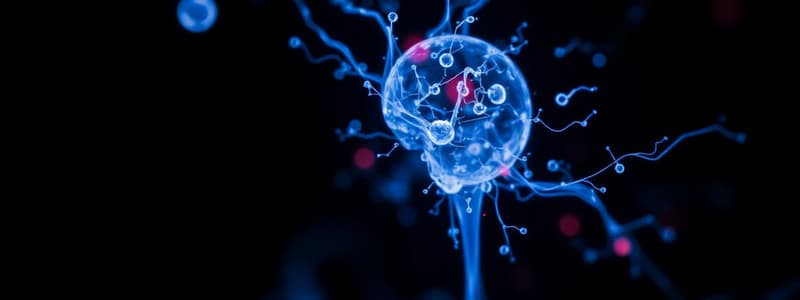Podcast
Questions and Answers
What role does the optic nerve play in visual perception?
What role does the optic nerve play in visual perception?
- Amplifies light signals before reaching the brain
- Processes visual information for memory
- Carries visual information from the retina to the brain (correct)
- Controls eye movement and focus
At what age does physical efficiency typically peak according to the provided information?
At what age does physical efficiency typically peak according to the provided information?
- Around 20 to 30 years old (correct)
- During infancy
- In late adulthood
- At birth
Which of the following best describes adolescence in the context of life stages?
Which of the following best describes adolescence in the context of life stages?
- A transition marked by sexual maturity and identity exploration (correct)
- A period of rapid physical growth with stability in identity
- A stage where individuals are focused solely on academic achievement
- A time characterized by physical decline and memory loss
What is the primary factor that affects physical growth and development during one's lifespan?
What is the primary factor that affects physical growth and development during one's lifespan?
What is true about the stage of late childhood according to the theories of life span development?
What is true about the stage of late childhood according to the theories of life span development?
Which factor is described as the biological process of trait inheritance from parents?
Which factor is described as the biological process of trait inheritance from parents?
According to the stage of life span, at what age range does early adulthood occur?
According to the stage of life span, at what age range does early adulthood occur?
Which theory suggests that physical characteristics play a significant role in understanding an individual?
Which theory suggests that physical characteristics play a significant role in understanding an individual?
What is the absolute threshold?
What is the absolute threshold?
What describes subliminal messages?
What describes subliminal messages?
Which function does the cornea serve in the visual system?
Which function does the cornea serve in the visual system?
What is the role of rods in the retina?
What is the role of rods in the retina?
How does sensory adaptation work?
How does sensory adaptation work?
What is inattentional blindness?
What is inattentional blindness?
Which factors can affect perception according to the content?
Which factors can affect perception according to the content?
Which type of photoreceptor is responsible for distinguishing colors?
Which type of photoreceptor is responsible for distinguishing colors?
Study Notes
Sensory Receptors and Perception
- Sensory receptors detect sensory information, leading to sensation.
- Absolute threshold: minimum stimulus energy required for detection 50% of the time.
- Subliminal messages: presented below conscious awareness threshold, affecting perception without awareness.
- Just noticeable difference (jnd): minimal stimulus difference needed for detection.
- Perception involves organizing and interpreting sensory information for conscious experience.
- Sensation is a physical process linked to sensory inputs.
- Sensory adaptation: reduced perception of constant stimuli over time.
- Attention significantly influences sensation and perception.
- Inattentional blindness: inability to notice visible stimuli due to lack of attention.
- Motivation affects perception, aiding in detecting meaningful stimuli shifts.
- Signal detection theory explains stimulus detection amid distractions.
- Perception is shaped by beliefs, values, prejudices, expectations, and life experiences.
Anatomy of the Visual System
- Cornea: transparent outer covering that focuses light.
- Pupil: adjusts to light levels, dilating in low light and constricting in bright light.
- Iris: colored part of the eye controlling pupil size.
- Lens: transparent structure enabling focus on objects at various distances.
- Fovea: area with concentrated photoreceptor cells for detailed vision.
- Photoreceptors: cones (color and bright light sensitivity) and rods (sensitive to low light).
- Rods play a vital role in night vision; inability to adjust can lead to night blindness.
- Optic nerve transmits visual information from retina to the brain.
- Optic chiasm: point where optic nerves from both eyes converge.
- Occipital lobe processes visual information from the optic pathway.
Unpacking the Self
- Self comprises physical, sexual, material, spiritual, political, and digital aspects.
- Physical self: influenced by growth, development, and hormonal changes during adolescence.
- Adolescent girls experience greater self-dissatisfaction, particularly between ages 13 and 15.
- Physical efficiency peaks during ages 20 and 30.
- Adolescence marks the transition from childhood to adulthood, beginning with puberty.
Stages of Life Span (Elizabeth Hurlock)
- Prenatal: developmental stage from fertilization to fetus.
- Infancy: lasts two weeks, characterized by rapid development.
- Babyhood: extends from two weeks to two years, focusing on behavior and socialization.
- Early childhood: ages 2 to 6, marked by questioning and imitative behavior.
- Late childhood: ages 6 to about 10-12, social dynamics and growth.
- Puberty: ages 10/12 to 13/14, marked by physical changes.
- Adolescence: ages 14 to 18, involving identity exploration and challenges.
- Early adulthood: ages 18 to 40, focuses on life establishment and value changes.
- Middle adulthood: ages 40 to 60, characterized by accomplishments and evaluations.
- Late adulthood/senescence: begins at age 60, associated with decline.
Factors Affecting Physical Growth and Development
- Heredity: biological inheritance of traits from parents to children.
- Environment: experiences and learning opportunities that shape growth.
- Chromosomal combination during fertilization determines physical characteristics.
- Autosomes: 22 pairs dictate various traits.
- Gonosomes: 23rd pair determining sexual characteristics.
- Dominant genes exert stronger influence than recessive genes.
Theories of Physical Self
- Physiognomy: interpretation of character based on physical traits.
- Five element theory: symbolizes health and personality in Chinese practice.
- Hippocrates: linked body fluids to individual temperaments.
- William Sheldon: categorized people based on body types, influencing personality perception.
Studying That Suits You
Use AI to generate personalized quizzes and flashcards to suit your learning preferences.
Related Documents
Description
Explore the fundamental concepts of sensation and perception in this quiz. Test your understanding of sensory receptors, absolute thresholds, subliminal messages, and just noticeable differences. Perfect for psychology students looking to reinforce their knowledge of these key topics.




